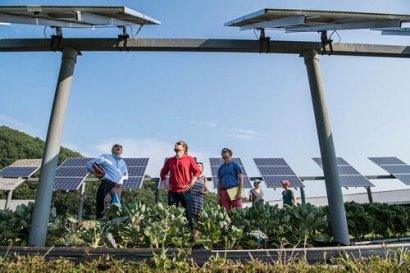| DATE | : 19 NOVEMBER 2020 |
|---|---|
| WRITER | : Emily Folk |
| PUBLISHER | : Renewable Energy Magazine |
We’ve devoted millions of acres of land to growing crops and allowing farm animals to graze. Now, that land used for agriculture can have a dual purpose — to harness the sun’s rays and provide energy.
Solar power is becoming increasingly popular. Energy harvested from the sun provides homes and businesses with clean power to meet their needs. Over time, solar panels can drastically reduce costs. However, they take up quite a bit of space.
Researchers have found that plants will grow and produce below elevated solar panels, and animals can still graze the land beneath the panels. Solar energy in agriculture has become possible, and it has proven results. Plus, it allows another stream of income for farmers.
The Beginnings of Agrivoltaics
The University of Massachusetts Crop Research and Education Center has been researching the compatibility of agriculture with solar energy generation, also known as agrivoltaics, since 2008.
In 2010, construction company owner Dave Marley partnered with researchers from the university to put 70 solar panels in place, elevated seven feet above farmland, with zero disruption to the soil.
Installers left enough space between the solar panels to allow sunlight to reach the plants below. The solar panels remain, as both the agricultural and solar farmers have benefited from the dual-use solar installations.
Crops Yield Beneath Solar Panels
Despite less sunlight reaching the crops beneath the solar installations, the crops still yield. Foraging plants, like grasses, generated about 90% compared to the crops not covered by solar panels.
The University of Massachusetts has also grown other plants besides grazing grasses, such as peppers, tomatoes, beans and cilantro. When placing the solar panels with three- to four-foot gaps between them, the vegetable plants produced almost the same amount as those not beneath the panels.
Usually, turf or gravel is the foundation lying beneath solar installations, but growing plants creates a safe, friendly environment for pollinators. Other researchers in Minnesota have grown native plants under solar panels to encourage pollination. The pollinators can then do their job and pollinate crops. Without pollination, crops can’t grow, and the economy collapses.
Although crop yields do not match the gains from full, open sunlight, the costs even out. The solar panels provide energy for farmers, which reduces production costs.
Large farm equipment can’t harvest crops grown under solar installations. Therefore, farmers must primarily harvest vegetables manually, so there are some limitations to what they can plant.
Animals Continue to Graze
Solar energy in agriculture works for farm animals, too. Solar panels elevated to at least seven feet above the ground allow livestock to continue to graze. Small animals, such as free-range chickens, require a mixture of sun and shade, which the panels provide. Plus, the chickens can easily access grasses and insects.
Even larger animals, including most livestock breeds and some horses, benefit from solar panel installations. Cows have an increased comfort level while grazing because they have access to shaded areas. Research at the University of Minnesota has shown that cows that were able to rest beneath solar panels had an internal temperature a half-degree lower than those who grazed in the sun all day.
Benefits of Agrivoltaics
Both landowners and solar developers have benefited from dual-use solar installations. For landowners, the solar panels provide self-generated energy, which decreases the cost of utility bills. The panels also block the wind and limit soil erosion to maintain soil health.
Solar developers don’t have to spend as much time preparing the land for installation, as most agriculture farms are already on level ground. Solar energy production increases because of the cooler temperatures in farmland locations, limiting the panels’ overheating.
Solar Energy in Agriculture
Solar energy can coincide with crop and animal agriculture. The National Renewable Energy Laboratory has continued to fund other research efforts in states across the country. With continued research and application, the future of solar energy in agriculture looks rewarding for energy conservators and farmers alike.

